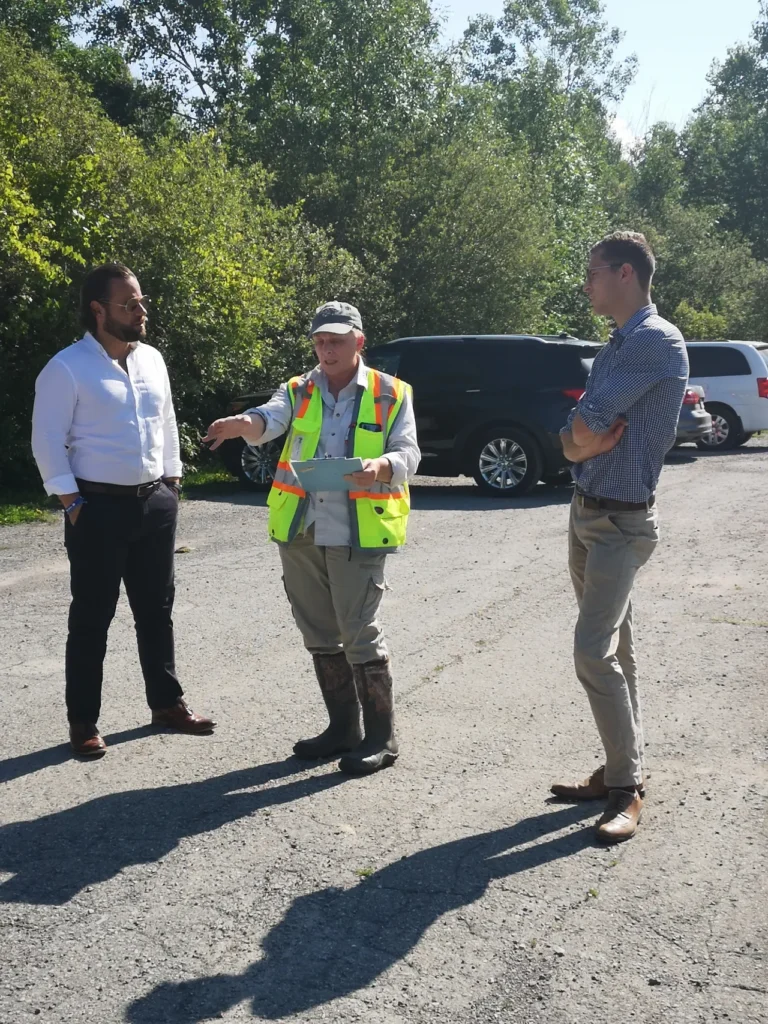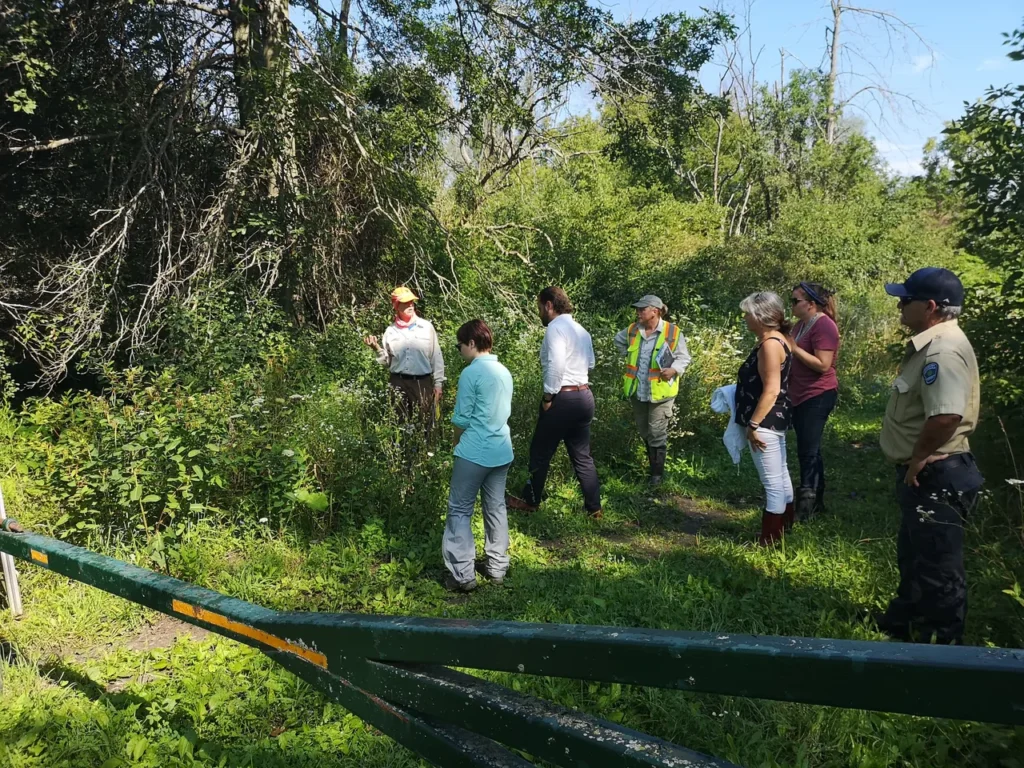The morning of August 4th was quite a unique experience for many members of the delegation of experts for the Wainfleet Bog Restoration project. Staff and representatives from 8Trees Inc., Six Nations of the Grand River, and the Niagara Peninsula Conservation Authority (NPCA) met with the Minister of the Environment, Honorable David Piccini, and several members of his Office, as well as MPP Sam Oosterhoff on Wednesday morning at the Wainfleet Bog Conservation Area entrance.
The meeting was organized by the Ministers’ Office as a field site visit to help the Minister gain a better understanding of the Species at Risk Stewardship Program (SARSP) funded project. Additionally, he wanted to speak directly to the delegation about their proposal to move a 1.4km stretch of Biederman drain that cuts into the Wainfleet Bog, back into the farm fields where it was originally designed.
The Wainfleet Bog is located upon the Six Nations lands, and is recognized as traditional harvesting territory of the Haudenosaunee people. Today, this significant wetland is known for its historical impacts from drainage and peat harvest. It is also home to several species at risk populations, including four species of turtles, and three species of snakes.
[Photo from left to right: Minister David Piccini, Anne Yagi (8Trees Inc. President), and MPP Sam Oosterhoff.]
The Biederman drain was moved into the peat soils of the Wainfleet bog sometime between 1935 and 1945 to better drain the site for peat extraction, which continued until the 1990s. Today, the activity has completely ceased, allowing for active restoration to take place.

The effects of peat harvest on such an ancient ecosystem has a variety of negative impacts on the plants, wildlife, wetland function, and global climate. For example, bogs are known to sequester and store carbon, and maintaining healthy bogs are considered to be a huge benefit for helping to balance carbon emissions. When bogs are drained and harvested, the dry peat experiences rapid decomposition resulting in extremely fast rates of carbon emission. For the Wainfleet Bog during dry years, 5 megatons of carbon are emitted per hectare per year, which equates to 40,000 cars on the road annually. This estimate does not include extreme conditions, such as when wildfires occur on site. Unfortunately, the Wainfleet Bog has also been on fire twice in the last decade; occurring in 2012, and 2016 due to its dry state in the summer.
Why is the Wainfleet bog so dry in the summer?
The simple answer is, drain maintenance.
Almost every wetland in the Niagara region is impacted by drainage, and the Wainfleet bog is no exception. The ongoing research by 8Trees Inc., has documented drastic changes in water levels within the site over several years, and have narrowed down the cause to drain maintenance activity, specifically beaver dam removals, in the section of Biederman drain that cuts into the southern edge of the bog. The Biederman drain normally experiences a lot of beaver activity, and beaver dams are built up over a year. Since beavers are a natural part of this ecosystem and known to be the best natural wetland engineer, they always choose the best place to build their dams to control water levels and create wetlands.
“If you let nature take over, it will eventually heal itself”, says Robin Vanstone, of Six Nations.
Both researchers and beavers are pointing to Biederman drain as being the best place to construct a dam to keep water levels elevated within Wainfleet bog. However, since this drain is managed by the municipality, it is required to be cleared out annually, to supply proper drainage to the farmlands surrounding the bog.
The Minister and Mr. Oosterhoff seemed very informed about this project, as it has been gaining attention by more stakeholders over the past several months. Both were very engaged in the technical description of the proposal by 8Trees staff, and asked several good questions.

[Photo: Cathy Blott (8Trees) explains the hydrology of the bog, showing the flow of tea-coloured bog water into the deep Biederman drain.]
“It has come to a point where we believe everyone understands and agrees that the goal is to have the bog hold more water. The next step is to decide on how to do this.” says Cathy Blott, an Associate Biologist with 8Trees Inc.
The time to address the drainage threat is right now. The Drainage report for Biederman drain is currently open, and it will close very soon. These reports are only open every 40 years. Changes to municipal drains can be made outside of this window but will likely take more time due to the Drainage Act process, and be more costly in the end.
Unfortunately, time is not on our side when dealing with endangered species populations.
The delegation has proposed to the landowner, the NPCA, to make the request to the Drainage Engineer, to re-align this section of Biederman drain to its original route, which still exists, through the farm fields to the south. This would result in the abandonment of the current section, leaving it open for beaver activity, provide a 300m buffer from the re-aligned drain and the bog edge, and remove the requirement for drain maintenance work along the abandoned section.
Some concerns raised are listed below:
1) the receiving landowners must be in agreement to accept the new drain route — communications with these individuals are underway.
2) the change will increase the amount of deer feeding in the farm fields — Although it is the opinion of the experts that the deer presence is likely not to change with the drain re-alignment, increasing hunting pressure in the bog may be a way to alleviate these concerns. Discussions are underway.
3) the old drain route through the farm fields is also through a mapped wetland feature, and it is against NPCA policy to put drains through wetlands. — Although it is true that the small wooded area around the old drain route is mapped as a wetland, historical imagery proves that this area was all farmed in the past, therefore exists in a degraded state, and should not compare in ecological value to the ancient Wainfleet bog with the survival of species-at-risk populations dependent on its long-term function.
Both Mr. Oosterhoff and the Minister appeared to be very positive about the work done on this project, and sympathetic to the concerns raised by each party.
We certainly appreciated this visit, and interest by our government representatives and hope the message about this project and ecological restoration in general gets more attention as time goes on.

